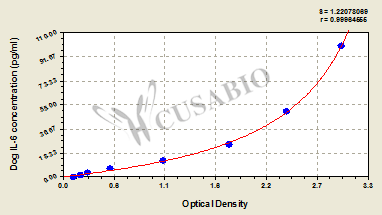Interleukin 6 (IL-6) is a multifunctional cytokine that plays important roles in immune responses, inflammation, and hematopoiesis. Originally identified as a B-cell stimulatory factor, IL-6 regulates acute-phase responses, promotes T-cell activation, and influences the differentiation of various immune cell populations. Multiple cell types produce this cytokine, including macrophages, T-cells, endothelial cells, and fibroblasts in response to inflammatory stimuli. IL-6 signaling occurs through binding to its receptor complex, triggering downstream pathways that affect gene expression and cellular functions essential for both innate and adaptive immunity.
The Dog Interleukin 6 ELISA Kit (CSB-E11260c) is designed for quantitative measurement of canine IL-6 in serum, plasma, and tissue homogenates. This sandwich-based assay offers a detection range of 1.56-100 pg/mL with a sensitivity of 0.39 pg/mL. The assay requires 50-100 μL sample volume and can be completed within 1-5 hours. Detection is performed at 450 nm wavelength, providing researchers with a reliable tool for studying IL-6 levels in canine samples.
Application Examples
Note: The following application examples are drawn from a selection of publications citing this product. For additional applications, please refer to the full list of references in the "Citations" section.
This ELISA kit has been used in veterinary research to measure interleukin-6 levels in canine serum samples across various experimental contexts. The applications span inflammatory biomarker studies and perioperative research examining cytokine responses during medical procedures.
• Inflammatory biomarker profiling - Quantification of IL-6 alongside other acute phase proteins and pro-inflammatory cytokines including C-reactive protein, serum amyloid-A, TNF-α, and IL-1β in comprehensive inflammatory response studies
• Perioperative research - Monitoring of IL-6 concentrations in surgical contexts, including measurements before premedication, during surgery, and at multiple post-surgical timepoints to evaluate inflammatory responses to medical interventions
• Pain and analgesia studies - Analysis of cytokine levels in conjunction with endorphin measurements during tramadol administration protocols in surgical settings






